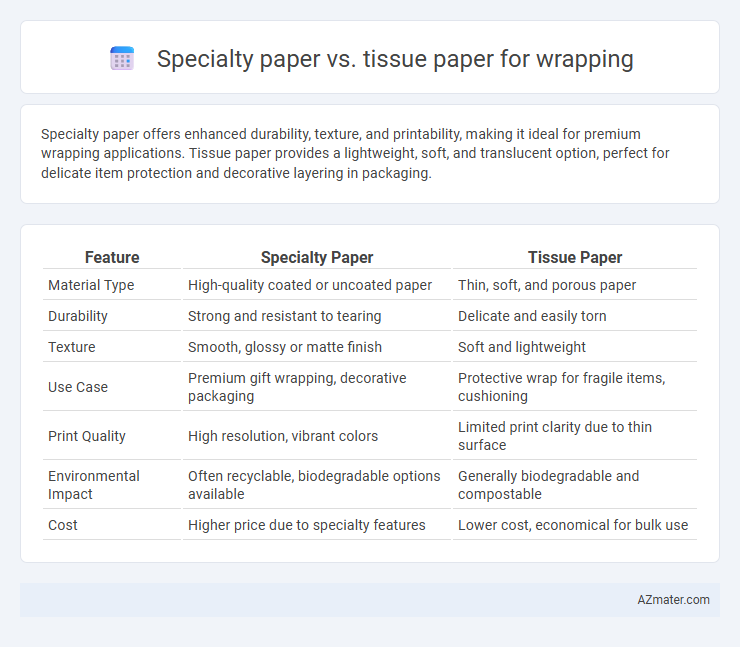Specialty paper offers enhanced durability, texture, and printability, making it ideal for premium wrapping applications. Tissue paper provides a lightweight, soft, and translucent option, perfect for delicate item protection and decorative layering in packaging.
Table of Comparison
| Feature | Specialty Paper | Tissue Paper |
|---|---|---|
| Material Type | High-quality coated or uncoated paper | Thin, soft, and porous paper |
| Durability | Strong and resistant to tearing | Delicate and easily torn |
| Texture | Smooth, glossy or matte finish | Soft and lightweight |
| Use Case | Premium gift wrapping, decorative packaging | Protective wrap for fragile items, cushioning |
| Print Quality | High resolution, vibrant colors | Limited print clarity due to thin surface |
| Environmental Impact | Often recyclable, biodegradable options available | Generally biodegradable and compostable |
| Cost | Higher price due to specialty features | Lower cost, economical for bulk use |
Introduction to Specialty Paper and Tissue Paper
Specialty paper and tissue paper serve distinct purposes in wrapping, each offering unique properties tailored for specific applications. Specialty paper is engineered for durability, texture, and aesthetic appeal, often featuring coatings, embossing, or enhanced strength to protect and showcase premium products. Tissue paper is lightweight, translucent, and soft, primarily used for delicate wrapping, cushioning, and adding an elegant finishing touch to gifts.
Defining Specialty Paper: Features and Uses
Specialty paper refers to high-quality, purpose-designed paper products that exhibit unique features such as enhanced texture, durability, and finishes, making them ideal for luxury wrapping applications. Common types include coated papers, metallic finishes, and embossed textures that provide superior aesthetics and structural integrity compared to typical tissue paper. Specialty paper is frequently used in premium retail packaging, gift wrapping, and artistic presentations where visual appeal and material strength are paramount.
Overview of Tissue Paper for Wrapping
Tissue paper for wrapping is a lightweight, translucent material commonly used to protect delicate items and enhance gift presentation. It is made from thin, flexible fibers that provide cushioning while allowing color and texture to complement the wrapped object. Specialty paper, by contrast, typically offers greater durability and decorative finishes, but tissue paper remains preferred for its softness and ease of folding around fragile products.
Comparing Material Composition
Specialty paper for wrapping is typically made from high-quality kraft or coated cellulose fibers, providing durability and resistance to tearing, while tissue paper primarily consists of thin, lightweight cellulose fibers offering softness and flexibility. Specialty paper often incorporates additives like clay or synthetic polymers to enhance strength and printability, whereas tissue paper remains more porous and delicate due to minimal processing and lower fiber density. The material composition differences result in specialty paper being suitable for protective packaging and decorative wrapping, while tissue paper excels in cushioning and delicate item wrapping.
Strength and Durability Differences
Specialty paper offers superior strength and durability compared to tissue paper, making it ideal for wrapping heavy or sharp-edged items. Its thicker fibers and reinforced structure resist tearing and provide enhanced protection during transit. Tissue paper, while softer and more flexible, is prone to ripping and best suited for lightweight, delicate wrapping needs.
Aesthetic Appeal and Printability
Specialty paper offers superior aesthetic appeal and printability for wrapping due to its textured finishes, vibrant colors, and high-quality surface that enhances ink absorption and sharp image reproduction. Tissue paper, while lightweight and translucent, provides a softer, delicate look but often lacks the robust print clarity and durability required for detailed designs. Choosing specialty paper ensures more vivid, professional results ideal for premium packaging and customized branding.
Eco-Friendliness and Sustainability Factors
Specialty paper designed for wrapping often incorporates recycled fibers and biodegradable coatings, enhancing its eco-friendliness compared to conventional wrapping solutions. Tissue paper, typically made from virgin or recycled pulp, excels in sustainability due to its lightweight nature and high recyclability, reducing waste and environmental impact. Both options support sustainable practices, but tissue paper's minimal processing and compostable qualities make it a preferred choice for environmentally conscious packaging.
Cost Efficiency and Affordability
Specialty paper offers higher durability and unique textures, making it ideal for premium wrapping applications though it generally comes at a higher price point. Tissue paper provides a cost-efficient alternative with its lightweight and flexible characteristics, allowing for affordable bulk purchases suitable for everyday wrapping needs. Businesses seeking budget-friendly solutions often prefer tissue paper, while those prioritizing presentation and added value invest in specialty paper despite the increased cost.
Ideal Use Cases for Each Paper Type
Specialty paper excels in luxury gift wrapping, offering a wide range of textures, finishes, and colors that enhance presentation and durability for high-end products. Tissue paper is ideal for delicate wrapping and cushioning, providing softness and breathability that protect fragile items like glassware, jewelry, or cosmetics. Choosing between specialty and tissue paper depends on the need for aesthetics versus protective layering in packaging solutions.
Making the Right Choice: Specialty Paper vs Tissue Paper
Specialty paper offers durability and a wide range of textures and finishes, making it ideal for luxury or decorative wrapping that requires a sturdy presentation. Tissue paper is lightweight, flexible, and often used as a protective or decorative layer inside gift boxes or bags, providing softness and subtle color effects. Choosing between specialty paper and tissue paper depends on the desired aesthetic, strength needs, and the type of item being wrapped to ensure both protection and presentation quality.

Infographic: Specialty paper vs Tissue paper for Wrapping
 azmater.com
azmater.com